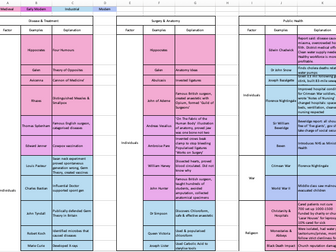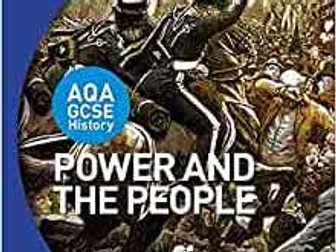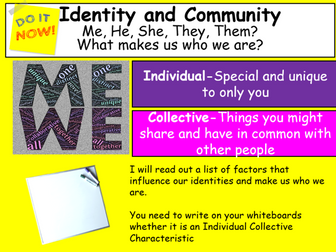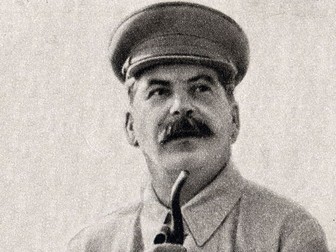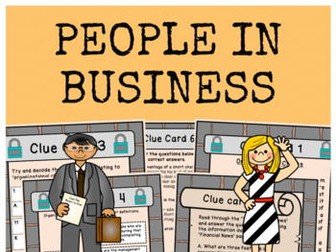
People and Communities - EYFS PSHE
People and communities - community EYFS PSHE lesson.
A detailed, fully resourced PSHE lesson suitable for EYFS/Reception age children. This lesson has been designed for use with children in Reception, however, the PowerPoint and activities could be adapted for use with other age groups.
In this lesson, the children will learn about communities and what it means to belong to one. We will discuss a range of examples including our family, class, school and local communities, as well as reflecting on the contributions we can make as individuals to make our communities better for everyone.
The lesson includes a sing-along starter (to ensure a swift start to the lesson), a video link to Amy June Bates’ The Big Umbrella, an adult-led focus task, independent activities to be carried out during continuous provision, and a plenary task.
Created to fit the new DfE and PSHE Association statutory 2020 /21 guidelines, the lesson includes a detailed PowerPoint, all editable with accompanying tasks and worksheets.
The lesson has been left editable and is filled with engaging activities. It is designed to be ‘no prep’, so you can just pick it up and use it, although it is still adaptable should you wish to.

People in the community matching exercise
A 3 way matching activity which requires students to match pictures of people in the community (such as police officers) to pictures of where you might find them and also to pictures of what they do.
There is also a page of key words. These may not be needed but may be useful for students that struggle with naming each picture or for spelling.

Belonging to a Community - KS1
Belonging to a community KS1 PSHE lesson. A one-two hour long, very detailed, fully resourced PSHE lesson suitable for KS1. This lesson has been created for Year 2, however, the contents may also suit younger students in KS2 (Year 3).
In this lesson, the students will be discussing what it means to belong to a community. We will look at a variety of groups that people can belong to and reflect on the way that we know we belong. We will identify the groups that we belong to, and any associated roles that we may have within these groups.
In our main task, we will take a detailed look at how we can make our community welcoming and inclusive to all groups, in particular, families who are refugees. We will read Kate Milner’s story ‘My Name is Not Refugee’ and complete accompanying tasks to reflect on the message behind the story.
The lesson includes a starter activity, a discussion task, a video clip with questions, a main activity and a plenary. Created to fit the new DfE and PSHE Association statutory 2020 /21 guidelines, the lesson includes a detailed PowerPoint, all editable with accompanying tasks and worksheets.
The lesson has been left editable and is filled with engaging, well differentiated and fun activities. It is designed to be ‘no prep’, so you can just pick it up and use it, although it is still adaptable should you wish to.
You can download a free example of our KS1 resources here:What is the Internet?
Who are EC Resources?
EC Resources are the top TES PSHE providers and are a group of teachers who work together to create easy to use, high quality and editable lessons and units of work. We have created lessons for The Children’s Commissioner, The Bank of England, MACS Charity, Tes, LikeToBe Careers, the Criminal Cases Review Commission (UK Gov) and have also completed PSHE and Citizenship commissions for schools across the UK.
You can contact us at info@ecpublishing.co.uk
Teaching PSHE, RE or Citizenship GCSE next year? Why not join our Citizenship and PSHE teachers Facebook group, with 8000 other teachers, for guidance, advice and resource sharing.

Unit 5 (P2) - People Skills and Communication
All: To understand the skills and personal attributes required for developing relationships with individuals
Most: to understand the importance of effective communication in HSC
This whole lesson covers P2 cirteria in Unit 5 - Meeting Individual Care Needs
Includes:
Engaging Powerpoint
Video
Worksheet - Case Study
Opportunities for discussions
Stretch and challenge questions

KS3 French : Describing people - communicative drills
A set of communicative oral translation drills to practise French adjectives with bilingual word lists
undefined

Famous LGBTQ+ Community List of People
128 famous people belonging to the LGBTQ+ Community including athletes, actors, singers, activists, writers etc
If theres a class of 32 theres enough names to make each student research 4 names and make a powerpoint of their findings.
We need to celebrate members of the LGBTQ+ Community to be more inclusive to the students we teach and to be more accepting of everyone.

Helping People & The Environment - Community Matters (KS1)
Community Matters is an exciting new free resource from the Archbishop of York Youth Trust providing activities and ideas to help pupils explore why community matters and how children and young people can play their part in creating positive change, particularly as we rebuild our communities post-Covid restrictions.
The KS1 resource has two packs focusing on Social Issues and Environmental Issues with a range of activities designed to ignite, inspire and empower children and young people to make community matter and explore what it means to live in the wider world, as active citizens. Each pack also contains ideas for collective worship.
Each pack contains:-
PowerPoint Presentation
PDF document with Teacher Notes

Communication - PHSE
Learning Objectives:
-To understand how positive communication can help when interacting with other people.
-To realise the importance of positive communication.
-To be able to develop your listening and observational skills.
- To understand the benefit of positive communication.
This is one of the best resources on this website! A must buy! Great power points, classroom discussion points, the students will definitely benefit from this! Purchase this resource now! Biggest bargain on this website - only £1! Due to high demand, this resource could be charged at £15 in the future, so buy now!

People in Organisations - HRM, Structure, Communications - A Level Business
Powerpoints, worksheets, games and case studies covering the topics of:
Human Resource Management
Communications
Organisation Structure

Social and Community Studies - Gender and Identity - LGBTQIA+ peoples
Part of a set of resources created for a senior Social & Community studies class in Australia (QCAA syllabus). The other resources are also available in my store - Aussie_Resources. Designed for use in 70 minute lessons. The end of term assessment for this unit was a 90 minute short response examination.
A lesson designed to teach students about groups which have been marginalised in the past (LGBTQIA+) and the importance of inclusivity. It begins with a discussion of whether students have seen television show Queer Eye and why it is important for marginalised groups to have representation in the media. Following this students are introduced to groups outside of the outdated ‘gender binary’ (e.g. androgynous, gender fluid / gender queer, transgender etc.) and to theconcept of gender dysphoria / gender nonconformity. Students are to take notes and engage in discussions of visual stimulus and clips (including some from the reboot of Will and Grace.) This lesson also introduces students to the various types of sexuality (Asexual, bisexual, pansexual, homosexual and heterosexual). Teach students about the importance of respecting people’s preferred pronouns. The second part of the lesson is skills based where students are introduced to one type of question from their upcoming exam.They must make inferences about someone based on their appearance + information about occupation (job) and personal interests. We talk through an ‘I do’ where my answers have been colour coded to show where I have provided evidence / addressed different aspects of the question. Following this, students have to do their own.

PHSE Assembly - helping people and the school community
Assembly with theme – helping one another / helping to look after something special / what makes us special.
Focus on school community and how the children and adults make the school special with being a specific type of role model.

History: Health & the People timeline
Timeline of AQA History Paper 2 Section A/A: ‘Britain: Health and the people: c1000 to the present day’ course organised into three catagories, then by factor.
The timeline is organised into three categories: ‘Disease & Treatment’, ‘Surgery & Anatomy’ and ‘Public Health’.
Within these catagories, examples are organised by factor: Individuals, War, Religeon, Chance, Government, Communication, Science & Technology, Economy
Examples for each factor are listed chronologically and colour coded by parts 1/2/3/4 in the textbook, followed by a short explanation, for example: Disease & Treatment | Individuals | Louis Pasteur | Swan neck experiment proved spontaneous generation wrong, Germ Theory, created vaccines
Perfect for teachers teaching or students revising for History GCSE exam content. Very useful for question 4.
I have many other history resources on exam technique and other courses available in my shop which pair nicely with this.

Community and being a good neighbour
This lesson gets students to think about what being part of a community means and why they should try to be kind to other people.
This is a PSHE lesson but would work just as well in Citizenship or as part of a tutor time program.
It focuses on the idea of the Social contract (i.e. treat others as you want others to treat you) by looking at case studies of poor behaviour.
The students really enjoy this lesson.

Power and the People GCSE History Factors
For the ‘Power and the People’ topic for the GCSE 9-1 History. For the final question on the paper, e.g. ‘Has religion been the main factor in causing protest in Britain since Medieval times?’ this resource provides evidence and explanation for the themes of communication, economy, government, ideas, religion, the role of the individual, war, and chance, effectively planning for every potential essay, with examples from c.1170 to the present day. This resource helped me get a 9 at GCSE.

Identity and Community
A ready to use, KS3 lesson complete with resources to meet the Citizenship and PSHRE Statutory Curriculum. Editable Powerpoint with 60 minutes worth of material.
Learning Intentions:
I can compare factors that influence individual and collective identity
I can evaluate the impact a diverse Britain has on communities
I can suggest how respect and tolerance can reduce inequalities in society
The Lesson focuses on factors that influence identity; students explore what communities they belong to and research how diverse Britain is. Students evaluate the pros and cons of living in diverse Britain and are introduced to the British Value of Mutual Respect and Tolerance. The Lesson includes the right to equality and supplements the Citizenship curriculum.
The Lesson includes resources that are non-specialist friendly.
PowerPoint and resources are in comic sans, with size 14 font and slides have a yellow background to ensure that it is SEN inclusive. The lesson includes differentiated learning tasks that challenge students to be critical thinkers. The lesson includes assessment for learning opportunities and an optional homework task. Students are encouraged to demonstrate their knowledge and strengthen literacy skills.
The PowerPoint has teacher notes with suggested teaching ideas and questioning, as well as suggested timings.
The Lesson includes:
Powerpoint
Diversity Research Table and info sheets
Homework task (Identity Shield)
Identity Profile Sheet
Tried and tested lesson used by both specialist and non-specialist staff used across inner city schools in the northwest.
If you want to save time and want all your resources in one place, why not download the Student Workpack which has everything included which can be also be used to ‘catch-up’ absent students.
For more Citizenship and PSHRE lesson, which meets the new Government SRE guidelines, please visit the shop ‘Empowered Learning’ on Tes.
This lesson is once bought and downloaded should not be resold. You have been issued a single licence for your own use and the right to grant a limited licence to your students to use the licensed material as part of your teaching and their own private study.
Teach With — copy, edit and provide the licensed material to those students you teach in any medium or format for the purpose of educating them and/or their private study.
No Sharing of Derivatives (except to teach) — if you remix, transform, or build upon the material, you may not distribute the modified material except to those people you teach.

Citizenship: British Values: Tolerance and Respect: People; skills and community
British Values: Tolerance and Respect: People; skills and community
PowerPoint presentation and work book that covers:
Aims:
Understand that we are all unique, we share some similarities but we are also different
Understand that different personalities and skills are important to help us work together as a team and community
Learning outcomes:
Define and match key words
Identify and tally people’s differences and similarities
Identify features or people and community
Match people and skills
Work together to make and play a game
Evaluate the game you made and played

British Values: Prevent: Tolerance and respect - People; skills and community
Contents of pack:
PowerPoint presentation that includes:
Aims:
Understand that we are all unique, we share some similarities but we are also different
Understand that different personalities and skills are important to help us work together as a team and community
Learning outcomes:
Define and match key words
Identify and tally people’s differences and similarities
Identify features or people and community
Match people and skills
Work together to make and play a game
Evaluate the game you made and played
Plus:
• Task sheets
• Fact or opinion activity
• Writing task
• Tolerance and respect word search
Could be useful, but would need adapting for US teachers.
Total slides/pages 33

What were people's experience of communism from 1917-1941 in the USSR?
A sequence of 12 lesson focusing on people’s experience of communism under Bolsheviks rule from 1917 extending to Stalin’s rule up until 1941. Retrieval and assessment based on sources is embedded throughout. A master presentation is included as well as a student booklet with all resources included.
Bundle

People in Business - MEGA Bundle!
Great bundle for teaching about people in business!
Included in this bundle are a variety of resources to teach about a variety of topics relating to organization and management and people in business. Each activity included in this bundle aims to build upon students understanding of organizational charts, the role of management, leadership styles and trade unions and many more topics. These lessons work perfectly for teaching the iGCSE Business Studies curriculum, however this bundle could be used for other courses.
Included:
Organizational Charts - Multiple Choice Quiz
Organizational Charts - Escape Room
Organizational Charts (Organizational Structures) - Full Lesson
Recruitment and Selection - Escape Room
Recruitment and Selection - PowerPoint
Training Methods - On-the-job & Off-the-job Training Activity
Training Methods - Multiple Choice Quiz
Training Methods - Escape Room
Taylor and Herzberg - The Key Motivational Theories - Full Lesson
Taylor and Herzberg - Business Studies - PowerPoint with Activities
Non-financial Methods of Motivation - Main Activity
Methods of Motivation - Main Activity
Motivation in Business - Printable Activities
Communication in Business - Multiple Choice Quiz
Business Communication Lesson - Escape Room
Communication Barriers - Full Lesson
Communication Barriers - Word Search
The Role of Management
The Role of Management - Escape Room
The Role of Management - Multiple Choice Quiz
If this bundle was helpful, please leave a review!

